The NBA offseason continues to bring surprising moves, and a recent three-team swap involving the Miami Heat, Los Angeles clippers, and Utah Jazz has reshaped rosters and sparked widespread debate among analysts. This complex transaction saw key players switch conferences, influencing immediate competitive outlooks and long-term strategic directions for all involved franchises. Expert analysis dissects the motivations behind each team’s participation and assigns grades reflecting perceived success in achieving their objectives. Understanding the nuances of this deal requires looking beyond the simple player swaps to grasp the strategic gambles and financial implications at play in the modern NBA landscape.
Unpacking the Three-Team NBA Trade
The core of this trade involved several notable names changing hands across three teams. Here is a precise breakdown of the assets exchanged:
Miami Heat Received: Norman Powell
Miami Heat Gave Up: Kevin Love, Kyle Anderson
Los Angeles Clippers Received: John collins
Los Angeles Clippers Gave Up: Norman Powell, 2027 second-round draft pick
Utah Jazz Received: Kevin Love, Kyle Anderson, 2027 Los Angeles Clippers second-round draft pick
Utah Jazz Gave Up: John Collins
This intricate movement of players and a draft asset tells different stories for each franchise involved, reflecting varying priorities ranging from immediate contention needs to financial flexibility and future asset accumulation.
Miami Heat’s Distinctive Approach
The Miami Heat’s involvement in this trade appears to align with their established philosophy, often dubbed “Heat Culture.” The move to acquire Norman Powell, while giving up veteran forwards Kevin Love and Kyle Anderson, drew a mixed reaction. On one hand, the value received for the outgoing players was considered exceptionally high. Norman Powell is a productive scorer, known for his ability to get buckets efficiently (21.8 points per game last season on 41.8% shooting from three). In isolation, acquiring a player of Powell’s caliber for Love and Anderson is seen as an “unrealistically good” return based purely on talent value. This earned the Heat an A+ grade for the value aspect of the trade.
However, the strategic fit and overall direction of the team were heavily questioned. Powell is primarily a shooting guard (standing 6-foot-3) who doesn’t significantly contribute to playmaking (averaging just 2.1 assists). His scoring profile and position overlap considerably with current Heat guard Tyler Herro. Critics argue that this move fails to address underlying needs or significantly elevate their championship aspirations. Instead, it seems to reinforce a commitment to winning now without a clear path beyond upholding the existing team identity. This strategic ambiguity led to a C- grade for the Heat’s direction, suggesting a potential risk of “inevitable burnout” without a more impactful roster transformation.
Los Angeles Clippers Seek Added Size
The Los Angeles Clippers entered this trade seemingly with the goal of increasing their size and adding a versatile offensive weapon. Their acquisition of John Collins was aimed at providing a lob threat and frontcourt scoring alongside Ivica Zubac and Derrick Jones Jr. While some analysts have differing opinions on Collins’ overall impact or defensive limitations, the author views him as more than just an aerial target. Collins demonstrated solid production last season, averaging 19 points and 8.2 rebounds with efficient shooting splits (near 53/40/85).
Collins’ known limitations lie primarily in positional fluidity; he’s a scoring power forward rather than a defensive anchor or versatile center. However, the Clippers reportedly believe their roster structure, featuring various player archetypes, is well-suited to optimize Collins’ strengths. Playing alongside a facilitator like James Harden could potentially allow Collins to flourish and significantly enhance his game. The cost of acquiring Collins was giving up Norman Powell and a 2027 second-round pick. Losing Powell, a valuable perimeter scorer, was considered a significant factor weighing on the Clippers’ overall grade. Factoring in both the acquisition of Collins and the departure of Powell, the Clippers received a B grade for the trade. The assessment included a caveat that this grade could improve if the Clippers effectively replace Powell’s scoring production, perhaps by acquiring another player through different means.
Collins’ Role and Fit in LA
John Collins brings a dynamic element to the Clippers’ frontcourt. While not a traditional defensive center, his ability to score inside and out, rebound effectively, and set screens offers a different dimension than Ivica Zubac. His past performance indicates he can be a high-level contributor when placed in the right system. The Clippers’ veteran-laden roster and offensive scheme, particularly with facilitators like Harden, could theoretically maximize Collins’ offensive efficiency and impact. The challenge will be integrating his defensive responsibilities and ensuring his strengths outweigh his limitations in the Clippers’ specific defensive schemes.
Utah Jazz Prioritize Financial Flexibility
The Utah Jazz’s participation in this three-team trade is largely understood as a financially motivated decision aimed at facilitating their ongoing rebuild. By sending out John Collins, the Jazz accepted Kevin Love, Kyle Anderson, and a 2027 Clippers second-round pick. The return in terms of immediate on-court talent or high-value draft capital was minimal, described dismissively as having the value of “unwashed trousers.”
The primary benefit for the Jazz is financial: shedding approximately $13 million in salary for the upcoming season and potentially clearing roster spots. This aligns with a long-term strategy focused on developing young talent and accumulating assets for the future. The underwhelming return for a productive player like John Collins, who is in his prime and offers high-level scoring, efficiency, screen-setting, and rebounding, highlights a perceived market trend where non-superstar, yet highly effective, players are significantly undervalued. While the Jazz cannot be blamed for market dynamics beyond their control, the low return for Collins resulted in a C- grade. This assessment is strictly based on the tangible assets received for a player of Collins’ proven capability. Contextually, the Jazz’s projected win total for the 2025-26 season is the lowest in the league at just 18.5 games, according to recent odds, reinforcing their position as a team focused entirely on the future rather than immediate competition. The grade leaves open the possibility of reassessment only if this move somehow indirectly contributes to the future superstardom of a draft pick, like Ace Bailey, indicating the Jazz’s focus is solely on asset accumulation and future potential.
Market Dynamics Impacting the Jazz
The difficulty the Jazz faced in getting significant value for John Collins reflects a broader trend in the NBA. Teams are increasingly hesitant to take on large salaries for players who aren’t elite, even if they are highly productive like Collins. The market favors either top-tier superstars, young players on rookie deals, or minimum-salary veterans. Players in the middle class, especially those on multi-year, eight-figure contracts, are often viewed more as financial burdens or trade sweeteners for bigger deals rather than primary assets themselves. This dynamic significantly limited the Jazz’s leverage, forcing them to accept a return primarily focused on salary relief rather than basketball value.
Overall Impact and Analysis
This three-team trade offers a fascinating look at differing team building philosophies. The Heat continue to tinker around the edges, trusting their culture and core while potentially risking stagnation. The Clippers make a calculated bet on fitting a productive player into their existing high-level roster to address a specific need for size and scoring punch. The Jazz lean fully into a financial and asset-accumulation rebuild, accepting minimal value for a starting-caliber player to clear future flexibility, a move underscored by their league-low win total projection. The trade also serves as a microcosm of the current NBA market, where financial considerations and perceived future potential often outweigh current, proven production for non-superstar players. Each team took a distinct path, and only time will tell which strategy ultimately proves most successful.
Frequently Asked Questions
What players were involved in the recent Heat, Clippers, and Jazz trade?
The three-team trade involved several key players. The Miami Heat acquired Norman Powell. The Los Angeles Clippers received John Collins. The Utah Jazz obtained Kevin Love and Kyle Anderson. The Clippers also sent a 2027 second-round draft pick to the Jazz as part of the deal. This exchange shifted a productive shooting guard (Powell), a scoring power forward (Collins), and two veteran forwards (Love, Anderson) between the conferences.
How did experts grade each team’s performance in this trade?
Expert analysis provided different grades for each team involved based on their specific goals and the return received. The Miami Heat received an A+ for the value they got in acquiring Norman Powell for Kevin Love and Kyle Anderson, but a C- for the questionable strategic direction and fit. The Los Angeles Clippers earned a B grade for acquiring John Collins, noting the benefit of adding size and his productivity, while acknowledging the loss of Norman Powell. The Utah Jazz were given a C- grade, as they primarily shed salary and received minimal on-court value or assets in return for John Collins, reflecting the tough market for their outgoing player.
Why did the Utah Jazz make this trade despite receiving a low return for John Collins?
The Utah Jazz’s primary motivation for trading John Collins was financial flexibility and clearing future salary commitments. While Collins is a productive player, the return of Kevin Love, Kyle Anderson, and a second-round pick held minimal on-court trade value. By shedding Collins’ salary (approximately $13 million for the upcoming season), the Jazz focused on financial savings and potentially opening roster spots. This aligns with their ongoing rebuild strategy, prioritizing long-term asset accumulation and flexibility over immediate competitive value, especially given their projected win total is the lowest in the NBA.
Conclusion
The three-team trade between the Heat, Clippers, and Jazz encapsulates various front office strategies currently at play in the NBA. Miami prioritized getting high value for outgoing pieces but drew questions about whether the acquisition truly moves the needle. Los Angeles targeted a specific need for size and scoring in John Collins, betting on fit within their system despite his limitations. Utah leaned fully into a financial and asset-focused rebuild, accepting a low return for a valuable player to gain flexibility. Analyzing these moves highlights not just individual player assessments but the broader market dynamics influencing team decisions in the modern league.




